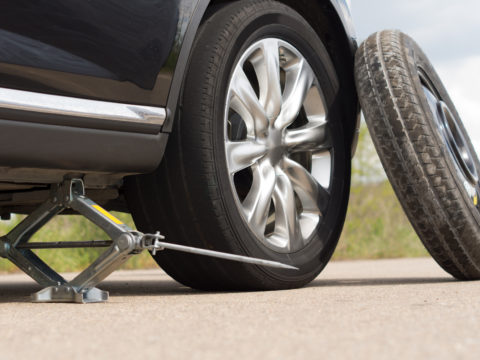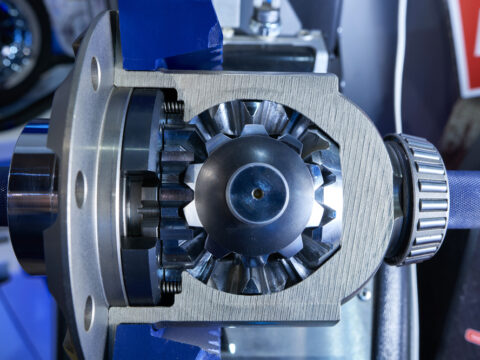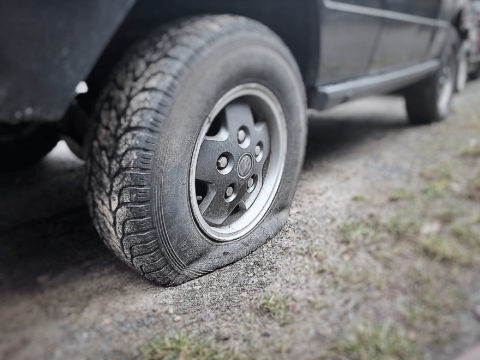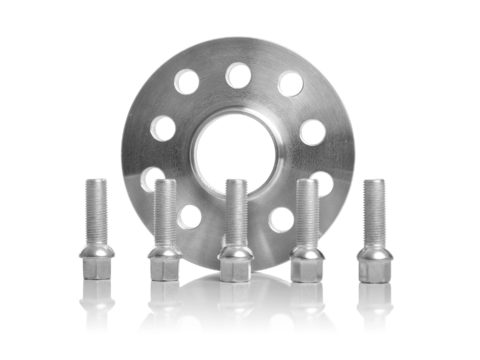It’s a common misconception that when your “low tire pressure” light comes on, it means you have to replace at least one of your tires. This article will explain the different causes of a low tire pressure light and how to fix them.
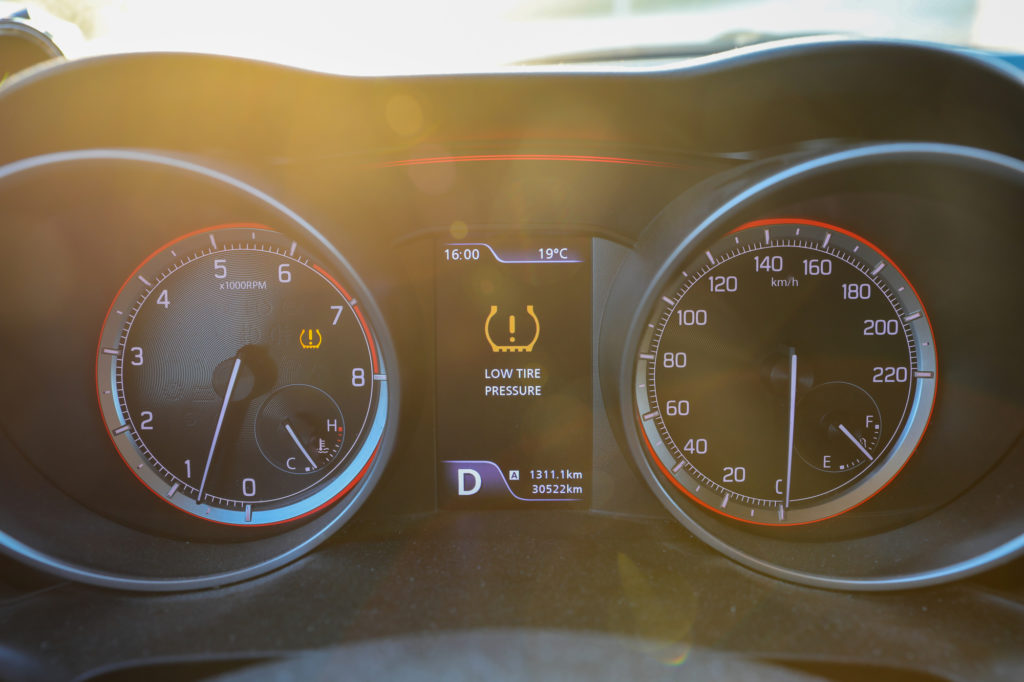
Contents
What Causes the Low Tire Pressure Light to Come On?
Several things could be causing your tire pressure warning light to come on. Here are five of them.
Low Tire Pressure
Your tire pressure is too low if the light comes on when you turn your car on, especially after a long period of driving. The ideal tire pressure for most cars is between 30 and 35 psi (pounds per square inch).
At that level, tires work best — they deliver good fuel economy and grip the road as designed. But, on the other hand, if the tire pressure is too low, the car will pull to one side while you’re driving.
Tire Pressure Too High
The tire pressure warning light comes on if the air pressure in your tires is more than 45 psi. That’s because higher-than-necessary tire pressure creates more friction between your tires and the road, reducing fuel economy. It also makes the car more difficult to handle. Check your owner’s manual for the correct tire pressure before topping off or releasing air from your tires.
Faulty Tire Pressure Sensor
The tire pressure sensor sends information to the car’s computer. The warning light will come on soon after starting your vehicle if it’s not working correctly. However, a faulty tire pressure sensor can cause other problems, such as inaccurate fuel economy readings or diagnostic trouble codes that trigger the check engine light.
Low-Profile Tires
If you drive a car that wasn’t designed to handle low-profile tires, the tire pressure warning light may come on while you’re driving. That’s because low-profile tires require higher inflation pressures than conventional tires. So check your tire label for the correct psi and inflate or deflate accordingly.
Cracked Valve Stem
A valve stem leaking air will trigger the tire pressure warning light. That’s because a leak means you’re losing necessary air from your tires as you drive. Replacing a stem is easy and relatively cheap — it shouldn’t cost more than $20 or so for parts.
Possible Reasons Why the TPMS Light Is on but Tires Are Fine?
Bad tires aren’t the only reason a TPMS light might come on. Here are five other possible causes and how to fix them.
Worn-out Wheel Sensor
The wheel sensor that works with your tire pressure sensor can get worn or damaged if your wheels aren’t balanced properly. If the wheel sensor is faulty, the TPMS light will come on when you turn the car on, just as it does when your tire pressure is too low.
How to Fix It
Replacing the wheel sensor isn’t difficult and usually costs less than $100 at a tire shop or auto parts store. Ensure that the new sensor matches the old one (some sensors are specific to particular wheels), and ask if they can set your TPMS when they replace it.
Bad TPMS Control Module
The control module can malfunction if exposed to a voltage spike, for example, from driving over a metal plate in the road. If that happens, the TPMS light will come on when you turn your car on and stay lit until you’ve had it checked at a repair shop. The cost of parts and labor will depend on the extent of the damage.
How to Fix It
The best way to fix a bad TPMS control module is by using a scan tool to recalibrate it. If you don’t have a scan tool handy, you can disconnect the battery — that will reset the TPMS control module, but you’ll lose any critical changes made to your car’s computer.
Bad Tire Valve Stem
A bad tire valve stem can cause the TPMS light to come on, but you’ll have to inspect several of them before you find the culprit if that’s the case. This process can be annoying but could save you the cost of replacing your TPMS control module.
How to Fix It
Fixing a bad tire valve stem is simple: replace the faulty component, and the problem should go away (or at least be reduced). However, make sure to check for damage when you take off the old valve stem — it’s possible to crack or split them by forcing them.
Bad Power Supply/Connection
If a power supply wire or connection is damaged or corroded, the TPMS light will come on when you turn your car on. The most likely place for a bad power supply is in your fuse box, which can be accessed from inside your vehicle. If that’s the case, you’ll need to call a professional mechanic to replace the affected fuse.
How to Fix It
Bad power supply wires can be identified by their brittle, cracked, or peeling insulation. Replace them as soon as possible — these wires are often near other essential parts of your vehicle’s electrical system and could pose a danger if left alone for too long.
Insufficient Voltage
Changes in temperature or sudden movements when driving can affect the voltage going to your tire pressure monitoring system, triggering a faulty signal from the TPMS. This is especially common with aftermarket performance parts, requiring a higher voltage input than stock components.
How to Fix It
You might be able to solve the problem by using a scan tool to recalibrate your TPMS system, but you’ll have to drive around for a while for this fix to take effect. If the problem continues, it could mean that you need to set your tire pressure warning system at a higher voltage level, which can be done through the vehicle’s computer.
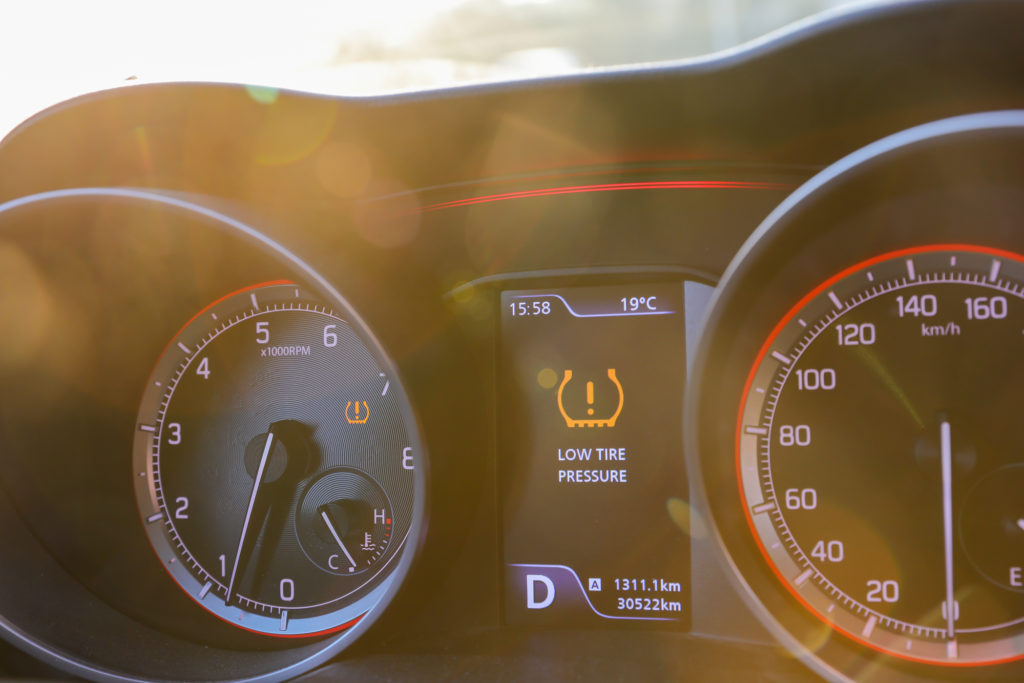
How to Reset Low Tire Pressure Light
The TPMS will stay on until you’ve fixed the problem, so it’s essential to know how to reset it. Here are five simple steps to follow:
Step 1
Check all four tires for low pressure, cuts, and other damage.
Step 2
Check the wheel sensors for dirt, corrosion, or loose connections.
Step 3
If you’ve checked your tire pressure and wheel sensors and determined that they’re alright, but the light is still on, try recalibrating your TPMS. You can do this with the help of a scan tool.
Step 4
If resetting your TPMS with a scan tool doesn’t work, disconnect your car’s battery to reset the system completely.
Step 5
If none of these steps solve the problem, you probably need to replace or repair your TPMS control module (which will likely require the help of a professional mechanic).
What to Do if the Problem Won’t Go Away
If your TPMS light stays on and you don’t feel comfortable taking the next step, you should have a professional mechanic inspect your car.
They’ll be able to diagnose the problem and fix it for you. You can also visit a mechanic for help if your TPMS uses low tire pressure warning lights in place of the tell-tale wheel sensors found on some vehicles or if resetting the TPMS doesn’t solve the problem in any other way. Fixing the low tire pressure light is simple — it’s getting to the root of the problem that requires help from a mechanic.

